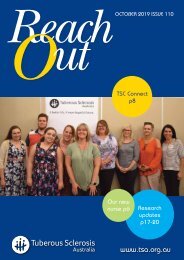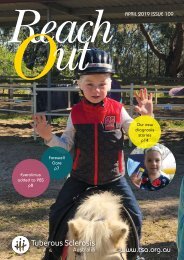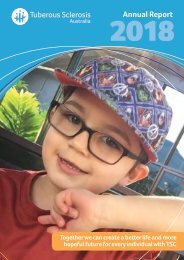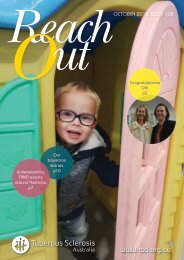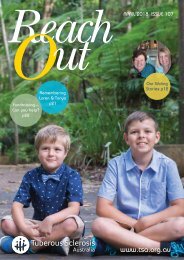Tuberous Sclerosis Australia Reach Out Magazine October 2016
Create successful ePaper yourself
Turn your PDF publications into a flip-book with our unique Google optimized e-Paper software.
Information<br />
Information<br />
New approach to treating<br />
epilepsy in babies with TSC<br />
shows promising early results<br />
From an interview with Dr Kate Riney, paediatric<br />
neurologist and TSC clinic lead at Lady Cilento<br />
Children’s Hospital, Brisbane<br />
Lachlan, QLD<br />
Can you describe this new approach to treating infants<br />
with tuberous sclerosis?<br />
The new approach is to look at the electroencephalogram (EEG)<br />
of babies with TSC before they’ve had a clinical seizure. A clinical<br />
seizure is one we can recognise just by looking at the baby. Some<br />
babies are diagnosed with TSC after the discovery of cardiac<br />
rhabdomyomas (a growth in the heart associated with TSC) in<br />
the baby during pregnancy but before they have clinical seizures.<br />
In these babies, we’ve had the opportunity to study changes on<br />
EEG that occur before a clinical seizure occurs. We’ve recognised<br />
that there is a clear pattern of abnormality appearing on the<br />
EEG approximately two months before the onset of clinical<br />
seizures. This gives us an opportunity to treat these infants earlier<br />
than would otherwise have occurred, and we know that earlier<br />
treatment of some seizure types is better. In some infants we<br />
have found from looking at their EEGs prior to clinical seizures<br />
appearing, that they are actually having seizures on the EEG<br />
that are just incredibly difficult to recognise in a small baby as<br />
they don’t cause very obvious movement or behaviour change.<br />
Identifying this has been important so that these can be treated.<br />
In short, we’ve learnt that the EEG can be incredibly informative<br />
when it is done regularly from birth for babies with TSC, even<br />
though they have not yet been seen to have a clinical seizure. The<br />
hope is now that with obtaining this information on all babies<br />
with TSC from early life, that earlier treatment might improve the<br />
development of clinical seizures or epilepsy and that it might even<br />
improve development.<br />
What type of seizures do you normally see in babies<br />
with TSC? What treatment do you use for these<br />
seizures?<br />
The most common seizures in small babies with TSC that we now<br />
pick up with EEG testing are focal seizures, these are seizures that<br />
stay localized in one part of the brain, arising from a tuber. They<br />
can have little visible effect on babies. Sometimes there is just a<br />
minor cessation in feeding, or a brief quietening in behaviour.<br />
When these have been occurring for a period of time, the seizures<br />
develop the capacity to spread wider around the brain and a more<br />
widespread seizure then appears. This is typically a seizure type<br />
called an epileptic spasm. The best first treatment for any type<br />
of seizures in an infant with TSC is a medicine called vigabatrin<br />
(Sabril). If seizures cannot be controlled by this medicine then<br />
there are a few other medications that can be trialled but the best<br />
curative approach may be removing the tuber causing the seizures.<br />
This is called epilepsy surgery.<br />
Matilda, VIC<br />
What research has been published on this new<br />
approach to treating infants with tuberous sclerosis?<br />
The original research[1] came from TSC clinics in Europe. It<br />
was initially in a very small group of babies that were followed<br />
with EEG before onset of clinical seizures. This showed that<br />
there was a potentially important role for EEG monitoring<br />
and possibly a role for treating the EEG to improve seizure and<br />
developmental outcomes.<br />
After this, larger studies are rolling out and these are active at<br />
the moment. Some data from these studies have been presented<br />
at international conferences, both at TSC and general epilepsy<br />
meetings. Some data is being prepared for publications in academic<br />
journals.<br />
In addition, studies have already been published recently<br />
that demonstrate that EEG is a valuable predictive tool [2-4].<br />
They show that if you follow EEG changes in babies with TSC<br />
before the onset of clinical seizures and you don’t treat that<br />
EEG that there is a timeframe of about two months where the<br />
EEG becomes abnormal and these babies will develop clinical<br />
seizures. This provides us with extra confidence in making the<br />
decision to treat an abnormal EEG before the babies have had<br />
clinical seizures.<br />
What research is your team at Lady Cilento Children’s<br />
Hospital involved in?<br />
Our TSC Clinic is collaborating as an <strong>Australia</strong>n site in a<br />
multi-centre research project running across European Union<br />
countries. This work is looking at early predictors of epilepsy<br />
in infants with TSC and determining whether earlier treatment<br />
when there are purely EEG abnormalities, but before clinical<br />
seizures appear, may improve outcomes. We are looking at both<br />
epilepsy outcomes as well as outcomes related to development<br />
and cognition.<br />
What else do we know about this new approach?<br />
As various clinicians become familiar with doing EEGs as a<br />
regular monitoring activity in small babies with TSC who have<br />
not yet had clinical seizures, there has been greater opportunity to<br />
see how EEG changes correlate with how the baby is progressing<br />
in their level of interaction and development. Through this time,<br />
clinical knowledge is being acquired about the baby and their EEG<br />
patterns. This allows clinicians to have the capacity to predict what<br />
will happen next and to have plans considered for treatment and<br />
intervention that can then be implemented more rapidly than if<br />
this knowledge was not already there.<br />
The EEG still gives you additional<br />
information over what families, parents<br />
or even doctors looking at the child can<br />
actually tell.<br />
It’s often a cause of worry and anxiety for parents and<br />
carers that they are not recognising subtle seizures<br />
in their babies. This worry can continue even after<br />
medication is started. What role does regular EEGs<br />
have for babies who have not had TSC diagnosed<br />
before they present with clinical seizures?<br />
I also see babies presenting for the first time with the onset of<br />
clinical seizures and TSC diagnosis at that time. I think the<br />
same principles still apply. The EEG still gives you additional<br />
information over what families, parents or even doctors looking<br />
at the child can actually tell. For this reason, I generally apply the<br />
same monitoring to any infant after the onset of clinical seizures<br />
as I would to the infant who is on the preventive surveillance<br />
EEG regime. I do think this helps to make sure that you’ve better<br />
control of the seizures over what is guessed clinically. And regular<br />
EEGs even after onset of a clinical seizure can still predict seizures<br />
breaking through later. I think the EEG surveillance, even in<br />
these infants, offers us the maximum information about the early<br />
developing brain to allow us to make the best decisions to improve<br />
the potential outcome.<br />
How frequent are these EEGs?<br />
This can vary from team to team. We follow the protocol that<br />
other researchers in Europe are following. For me, this is our<br />
minimum frequency:<br />
• For babies up to 6 months of age, once every four weeks;<br />
• For babies between 6 and 12 months of age, once every<br />
six weeks;<br />
• For babies between 12 and 24 months, once every<br />
eight weeks.<br />
In practice, if there is an abnormal pattern on EEG or a very active<br />
EEG, I might do EEGs every two weeks as I change medications to<br />
try to get better control.<br />
We’ve discovered there are some specific windows of time in<br />
the life of a TSC baby when they are more susceptible to having<br />
seizures. These are the times in which we tend to see more abnormal<br />
EEGs, so we’re often doing more EEGs in those time windows.<br />
For some babies, they are born with lots of sub-clinical seizures on<br />
their very early EEGs just after birth. We then have a group of babies<br />
that will develop EEG patterns that suggest a risk of developing<br />
epileptic spasms at around 6 months of age. And then there seems<br />
to be another risky period at about 18-20 months of age when some<br />
breakthrough seizures can occur, often with viral illnesses, but<br />
after that last risk period, things tend to be more smooth sailing.<br />
14<br />
<strong>Reach</strong><br />
<strong>Out</strong><br />
OCTOBER <strong>2016</strong> ISSUE 104<br />
15





![TSA Reach Out April 2022 [Final]](https://documents.yumpu.com/000/066/687/587/3d369bd665bdb406a759500f62e2cfad0ccb7b3d/47512b4a703265727550565249426664566a727454513d3d/396a524e7354316d3867454b587243526164724c52673d3d.jpg?AWSAccessKeyId=AKIAICNEWSPSEKTJ5M3Q&Expires=1714348800&Signature=hIUsK4zksF9omkKcTkO0zSD2doY%3D)
![TSA AR 2021 [WEB] (1)_FINAL](https://documents.yumpu.com/000/065/886/431/1afb21934ac6c444cd384e5fd7403d62e47080ce/426853747566526573646568546777594b4a4a5734513d3d/547274595943503850786275754544495972536c52513d3d.jpg?AWSAccessKeyId=AKIAICNEWSPSEKTJ5M3Q&Expires=1714348800&Signature=ifAaPLAM9zYVOywGVE0eanPp4UA%3D)

![TSA Reach Out Apr 2021 [WEB]](https://documents.yumpu.com/000/065/442/909/1e583cb2acba0eaa7f1aae53e14a0cf408aa56c4/7871796d694459464d707163324830746459484671673d3d/45356637637a3369494f764f4c3858495549795251513d3d.jpg?AWSAccessKeyId=AKIAICNEWSPSEKTJ5M3Q&Expires=1714348800&Signature=hrWhb8pvfONyXrQkZ1kRlhSmc34%3D)




